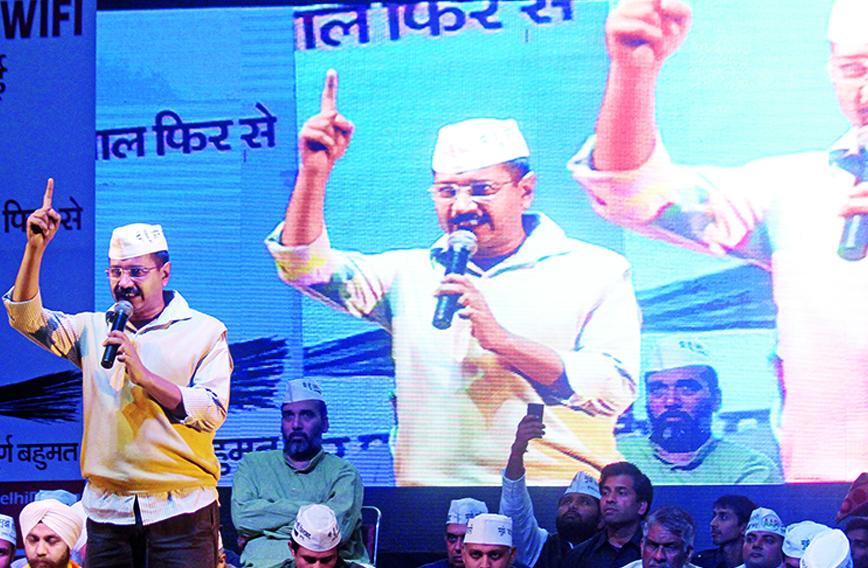
SANJAYA BARU
AFTER the Indian National Congress morphed from being a national movement into a political party, several civil society movements have tried to make this transition. The most prominent among them being the Dravidar Kazhagam (DK), led by Periyar, that evolved into more than one political party. In the 1980s the leadership of the students’ movement in Assam moved from street protest to state governance. The All Assam Students Union (AASU) and various other offshoots of the students’ movement emerged and withered as political parties. The agitation for a separate state of Telangana led to the creation of the Telangana Rashtra Samithi (TRS) that was in office for a decade.
None of them came out of a movement stirred by the urge to fight and root out corruption in public life and ensure good governance in the way that the Aam Aadmi Party (AAP) came into being. Coming together as India Against Corruption (IAC), exposing misrule during the second term of the United Progressive Alliance (UPA) government, a motley group of individuals inspired hundreds of young idealists who had grown tired of what they viewed as a ‘paralyzed government’, to form a political party that eventually grabbed power. Like so many popular civil society movements that made the transition from the street to government, AAP too found itself fighting elections and forming a government.
The damning incident of senior Union ministers Pranab Mukherjee and Kapil Sibal rushing to the Delhi airport to greet yoga guru and business baron of alternative medicine Baba Ramdev symbolized the UPA government’s utter desperation to cling to power. Several apparently high-minded individuals including Anna Hazare, Kiran Bedi, Yoginder Yadav, Prashant Bhushan and Arvind Kejriwal emerged as beacons of hope for thousands of young people in search of better and more honest governance.
Kejriwal proved to be a clever political tactician. He soon settled down to the usual business of sidelining other leaders within the movement and consolidating power. His real leap to unquestioned power in 2015 was a consequence of his defeating Narendra Modi’s Bharatiya Janata Party (BJP) at a time when it was still busy celebrating its historic victory. Kejriwal was the David who had stolen the ground from under the feet of Goliath. Ever since then, the unseating of Kejriwal became an obsession with Modi. Hence, the BJP’s victory in the Delhi State Assembly elections must taste particularly sweet for Modi.
While psephologists and political analysts would look at electoral data and communication to explain this change, political sociologists have before them a case study worthy of research on how a social movement transformed into a political party and was defeated on the very basis on which it came to power — the popular perception of persons in public office getting corrupted. Modi used the liquor licences issue to first damage Kejriwal’s personal reputation as a crusader against corruption and then systematically incapacitated his party and government to deliver the final denouement.
Kejriwal’s original sin was to alienate many senior colleagues from IAC and imitate the governance style of statist political parties wherein party leadership and government leadership vest with one individual. He owes his success in retaining power for a decade and, importantly, registering a respectable electoral performance, in terms of vote share, even in defeat to two factors.
First, the social welfare agenda AAP pursued, especially in improving the quality of and access to public health and education. This made the AAP government stand apart from any previous government in Delhi and most state governments across the country. In the highly class-divided national capital the poor and the lower middle class remained loyal to AAP. In my own residential locality in South Delhi our household help put it well. “All the owners of homes here,” she said to us, “vote for BJP. All the household helps vote for AAP.”
Second, the virtual absence of any credible local leadership within both the BJP and the Congress. The few who were there were sidelined by the leaderships of both national parties. Moreover, AAP had several high-quality performers like Manish Sisodia, Saurabh Bharadwaj and Atishi Marlena who had no rivals of any repute in either the BJP or the Congress. As a voter in South Delhi I can vouch for the sincerity, commitment and honesty of our local AAP MLA, Saurabh Bharadwaj. Pity he lost.
The tragedy for AAP was Kejriwal’s no-holds-barred ambition to go national. In trying to do so he fell victim to the usual political habit of raising revenues by all means. He adopted several suspect mentors among regional parties. They were cleverer. He was not. Every political party raises funding through legitimate and illegitimate means. Sometimes the means are legitimate but dubious, like electoral bonds. Most parties have learnt how to collect funds without getting caught. Kejriwal was in too much of a hurry to learn such tricks. Most of his colleagues were too honest to want to learn such tricks. In the event, the cookie crumbled.
AAP’s impressive vote share and reasonable representation in the State Assembly means the party can remain around till the next election. However, it must introspect deeply and find new ways to inspire its support base. Maybe the time has come for Atishi Marlena to in fact take charge of the party as Leader of the Opposition and make a mark for herself. She has proved to be a fighter and can emerge as a powerful voice of a younger generation. AAP was once a ray of hope in Indian politics. It has to find ways to regain that elan and edge. India needs a different kind of politics than what most mainstream parties are capable of and willing to offer.
Sanjaya Baru is a writer and Distinguished Fellow at the United Service Institution of India
Comments
Currently there are no Comments. Be first to write a comment!




